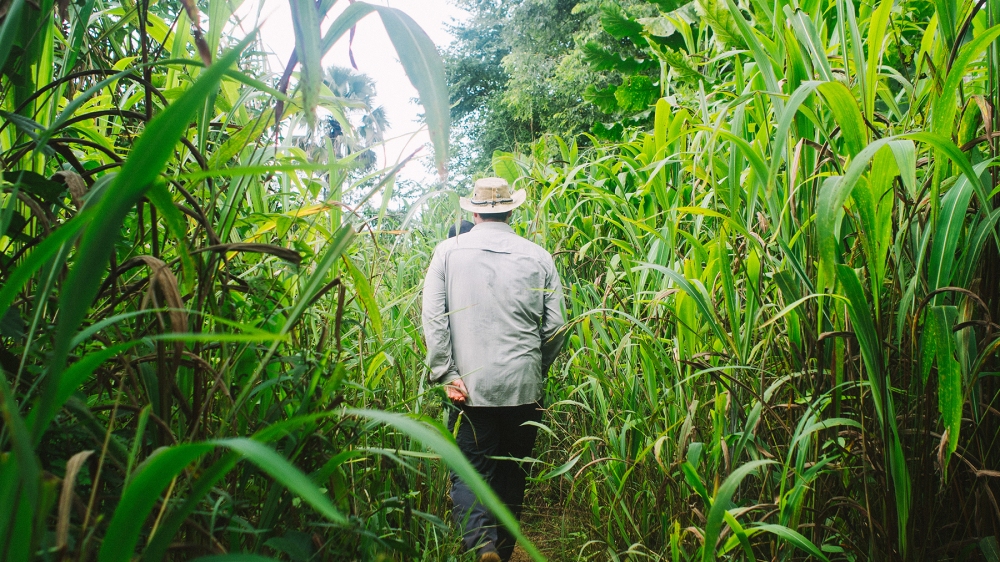The Beautiful Dream
The dream begins with a partial closing of canopy overhead. I can still see the dappled light of day, and so can the understory plants and grasses; yet we all remain protected from the harshest sun and wind.
There is moisture in the soil, fueling a smoldering biofire under foot. We can smell it. It smells like the earth.

There is food overhead, at eye-level, slightly below, inside and outside of direct vision, and below the surface. Everything a human could need. A kaleidoscope of green, with bits of bright color peeking out from here and there like playful children. Birds come to take a brief inventory. For a moment, cats are placed on high alert, then return to catmint.
I am clothed, but don’t need to be. I am warm and beyond the sight of others. I feel protected. More protected than at any time in my adult life.
Mind is fully occupied by life welling up around; active in alertness, without a thought.
Leaf litter gently yields to undirected travel.
There is a kiosk. It contains information about the garden: the plant species, the common and scientific names, images at various stages of growth with emphasis on what it looks like right now, how to identify it, what lookalikes there are, nutritional information, history of cultivation, a map showing the areas of the forest garden it can be found in, what parts are edible and what role it plays, how to harvest and prepare it for eating.
There is also information on tending the garden. Most needs are accounted for passively in the very design, but sensors are active throughout, causing instructions to appear on displays for providing water, mulch, compost, organic liquid fertilizers, worm castings, etc. Stations are positioned conveniently nearby for providing those needs. Anyone can participate. Everyone is encouraged to. People who pass through this garden will take food and leave nutrients. They are sustained, and in turn sustain. The wealth of the garden increases naturally year after year.
In the evening, visitors are invited to gather in a spacious light-filled room for dinner. It is not required, but most everyone does. All of the seasonal produce from the garden is represented in some form or other, and it’s all prepared with great affection. Some of the cooks are here for an extended stay. Others are passing through and lending a hand, learning along the way. The guests nod and smile in appreciation as they recommend and pass vessels of food to each other, but are otherwise mostly silent. It’s not against any rule to speak. It has simply become largely unnecessary. All minds have become quieted in the mutual security the design of the world now affords them.
Beyond this place are countless more such forest gardens positioned across the earth; each with its own magical blend of regional species. There is a silent mag-lev train, powered by solar, connecting them all. It is designed to require little maintenance. It does not require fare.
If you prefer to walk, there are also paths to travel on foot. Many do.
My life is traveling from garden to garden, getting to know all of creation, tasting every species of plant that I can, observing every animal that makes its presence known, and lending time to the maintenance of each garden as I go.
The edges bustle with a few critical industries. There are exquisite clothes and shoes, public access to the internet, medical service providers for everything from headaches to brain-activated prosthetic limbs. And many others. The most often needed products and services are closest to the forest dwellings. All goods and services are provided without cost.
One may encounter musicians and other performers now and then, but mostly, the culture no longer actively seeks entertainment. Still, a young minstrel playing an instrument with love may draw an impromptu gathering the same way a songbird may draw the eye and ear for a time. There is no money to offer, and gifts abound all around. Sometimes, a deeply touched heart may make a special offering with a found element from nature or other small object crafted by hand, as a show of appreciation. People are rarely seen carrying anything, other than their youngest children.
Men and women of action still take to the hills for climbing, hiking, swimming, and sometimes sports like skiing and biking. Some extreme sports such as wing-suit flying and sky-diving also remain, with a scattering of participants.
Visual art has become mostly unnecessary in the exuberance of nature, except for information design, and the forms and surfaces of architecture and garden. Some still paint themselves with vibrant patterns expressing oneness with nature, emotions, or other states of mind, in the traditions of African, Native American, and Amazonian tribes. Others produce forms that fold back into the fabric of nature over time. Art is almost never stored with attempts at artificial preservation, except to commemorate the period known as history. To preserve that which naturally wishes to pass away is seen as a losing battle with the inexorable forces of entropy, and something akin to idolatry. There are no advertisements for the eye to see. There are in fact very few static images to see at all. Even immersive video games have fallen out of favor with the youth. People have lost their taste for illusion. It was shed along with the irresistible compulsion to escape from a violent and unpleasant world.